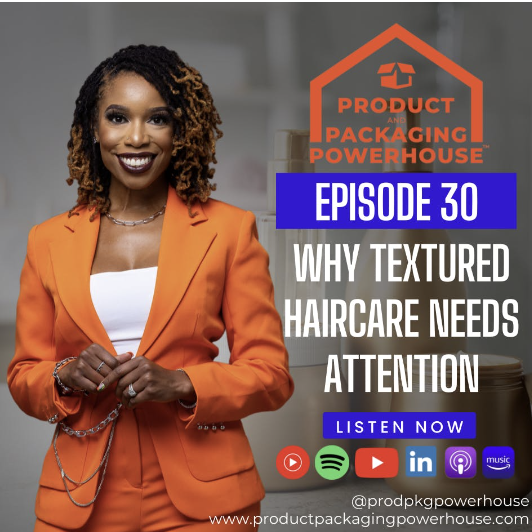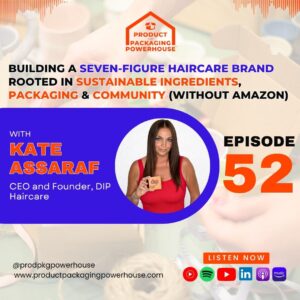In a recent episode of the Product & Packaging Powerhouse podcast, host Megan Young Gamble discusses the growing significance of textured hair care and the need for education within the beauty industry. Drawing from her personal experiences as a Black woman with textured hair, Megan dives deep into the history, challenges, and advancements of textured hair care, while stressing the importance of inclusivity and proper education in cosmetology schools.
Here are the key insights from the episode:
1. The Prevalence of Textured Hair and Lack of Training
Despite textured hair making up 65% of the world’s population, many beauty professionals lack the training to properly care for it. Historically, beauty schools and cosmetology programs have not provided sufficient education on textured hair. This gap has led to stylists being ill-equipped to serve clients with curly, coily, or kinky hair types, a reality Megan encountered firsthand. Fortunately, change is on the horizon with states like New Jersey and California now mandating textured hair care education as part of the curriculum. However, this shift needs to expand across more states and countries to ensure stylists everywhere are properly trained to care for all hair types.
2. Explosive Growth of the Textured Hair Care Market
The textured hair care market is experiencing rapid growth, with a compound annual growth rate of 5%. Consumers with textured hair, particularly women, spend 78% more on hair care products than those with straight hair. This increased spending is due to the wide variety of products needed to cater to textured hair’s unique needs—especially across different seasons and styles. From shampoos and conditioners to deep treatments and styling creams, the demand for specialized products has driven brands to invest in developing new solutions for this audience. What’s more, consumers are now seeing a broader range of brands on store shelves, from large beauty companies to smaller, niche startups.
3. Diversity in Hair Care Brands and Product Offerings
Twenty years ago, textured hair care products were sparse, with only a handful of brands offering basic solutions for textured hair types. Today, the market is expanding, with major retailers like Target, Sephora, and Walmart dedicating more shelf space to textured hair care. Brands like Mielle, Curls, The Mane Choice, and Shea Moisture have carved out significant space in the market, while celebrity-owned lines like Fenty Hair by Rihanna and Cecred by Beyoncé are also making waves. This diversity in offerings is a testament to the growing recognition that textured hair deserves the same level of attention and care as other hair types.
4. The Seasonal Challenges of Textured Hair Care
Textured hair requires different products and care routines depending on the season. For instance, during the summer months, textured hair may need lighter products to define curls and combat humidity, whereas in the winter, moisturizing and protective products are essential to prevent dryness and breakage. Megan shared her personal journey of experimenting with various hair products—from transitioning between styles such as natural fros, braids, and now locks—and the challenges of finding the right combination of products for each hair type and season. This is why consumers with textured hair often purchase a wider range of products, further highlighting the importance of well-formulated solutions tailored to this unique demographic.
5. The Critical Role of Education and Inclusivity in the Beauty Industry
One of the most important points Megan emphasizes is the need for inclusivity in the beauty industry, particularly in education. Despite the growing range of products for textured hair, the lack of formal training for stylists remains a critical issue. While progress is being made in certain states with the introduction of mandatory textured hair training, more work needs to be done. The Textured Education Collective—a group of hair industry leaders—is advocating for the integration of textured hair care education in beauty schools nationwide. Megan also mentions that over 75% of stylists have expressed a desire for more training in textured hair care, recognizing that without it, they are unable to serve a large portion of their clientele. The inclusion of this training not only benefits consumers but also allows beauty professionals to build more comprehensive skills that can serve a wider, more diverse audience.
6. Textured Hair Care Is Here to Stay
Textured hair is not a trend—it is a fundamental part of the beauty landscape. Megan makes it clear that textured hair care is not going anywhere, and the industry must continue evolving to meet the needs of the 65% of the population that has textured hair. While there has been significant progress in product offerings and education, more can be done to ensure that stylists and consumers alike are equipped with the knowledge and tools to care for textured hair.
Conclusion
Megan’s podcast episode serves as a powerful reminder of the importance of textured hair care and the work still needed to make the beauty industry more inclusive. As the market for textured hair products continues to grow, so does the need for proper training and education in cosmetology schools. With over 65% of the world’s population having textured hair, this is not just a beauty trend—it’s a vital shift toward recognizing and meeting the needs of a diverse population. Whether you’re a stylist, a beauty brand, or a consumer, now is the time to embrace the textured hair movement and continue pushing for inclusivity in the industry.

Megan Young Gamble, PMP® is a forward-thinking packaging and project management veteran with more than 10 years’ of experience transforming mere ideas into consumer product goods for today’s leading beauty, wellness, and personal care brands. Known amongst colleagues and clients for her perseverance and “see it through” mentality, Megan The Project ExecutionHER® is the owner and principal consultant of GLC, packaging & project execution team for CPG brands, Co-Owner of Pallet Pros, and Host of Product & Packaging Powerhouse Podcast.
- [FREEBIE] Learn about “day in the life” of a Packaging Project Manager → Get our “Starter Packaging PM Freebie” [link] https://glc.ck.page/thestarterpackagingprojectmanager
- Subscribe & Access our Video Vault YouTube Channel [ link] https://bit.ly/GLConYouTube
- Join our Email List [link] https://glc.ck.page/55128ae04b
- Follow and Connect with Megan on LinkedIn [link] https://linkedin.com/in/megangamble
- Learn about GLC, Packaging & Project execution firm for CPG brands http://www.getlevelconsulting.com
- Work with Me @ GLC, Schedule Discovery Call https://calendly.com/getlevelconsulting/15-minute-insight-session






